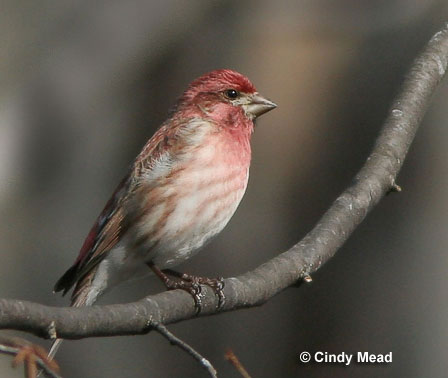The Purple Finch is well-known for the males’ bright purplish-red plumage. This seed-eating forest bird with a sweet warbling song largely relies on conifer cone crops, whose availability dictates population numbers and migration patterns.
Resembling its main competitor – the House Finch, the two species can be challenging to tell apart.
On this page
Description of Purple Finch
This medium-sized finch is plump and chunky, with a visibly notched tail. An average body length is 4.7-6 inches, and the weight is 18-31g. The beak is massive, conical, relatively short, and pointed.
You could say that the base color in both sexes is light brown. However, the males have distinct, namesake purplish-red splashes.
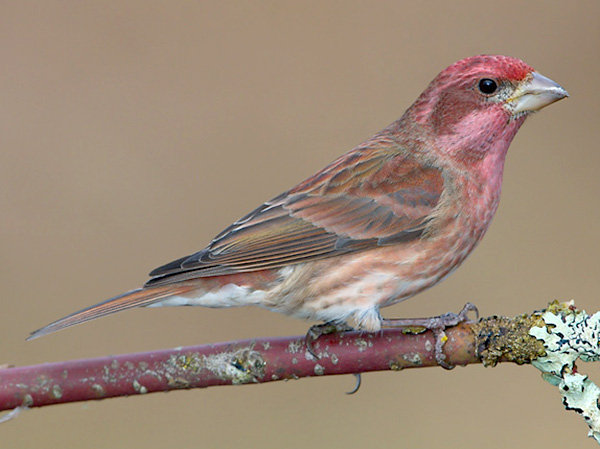
Photograph © Glenn Bartley.
Wing shape
The wings are relatively short, with pointed ends – typical of finches. The wingspan is 22 -26 cm. The wing bars are rosy, with a long primary projection.
Breeding Male
The breeding male’s upper parts – from the head to the back to the breast – come in raspberry-red splashes of varying intensity.
The brightest red feathering is on the head and the rump; the back and the hind neck are deep red with brown streaks. The underparts are light with reddish smudges; the wings and upper tail are brown, and the belly and the under-tail covert feathers are white.
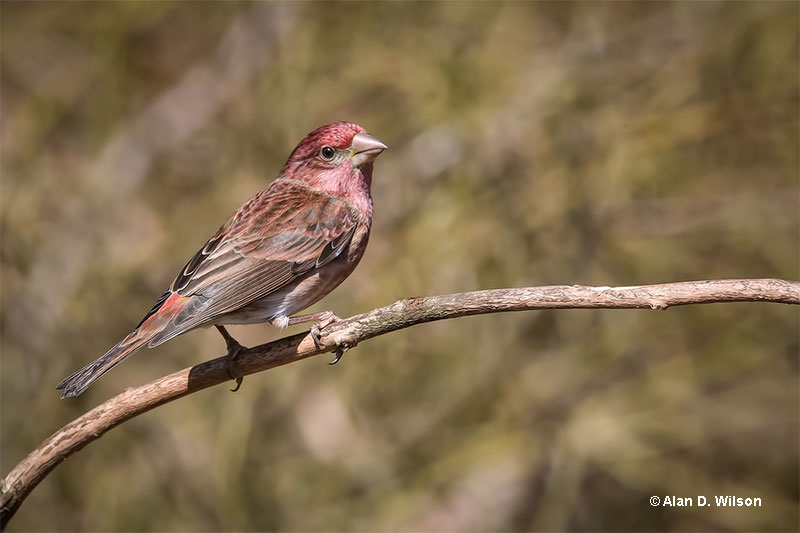
Male Purple Finch. © Alan D. Wilson
Female
Female completely lacks the bright namesake coloration. The dominant colors are brown, white, and grey. The upper body parts are brown with light grey streaks, with solid brown wings, the tail, and the rump.
Related: 17 finch species you can see in the U.S.
The underside is white with brown streaks, except for the belly and the under-tail covert feathers that are white. There is a distinct facial pattern, too – a dark ear patch, a white stripe over the eye, and a white “mustache.”
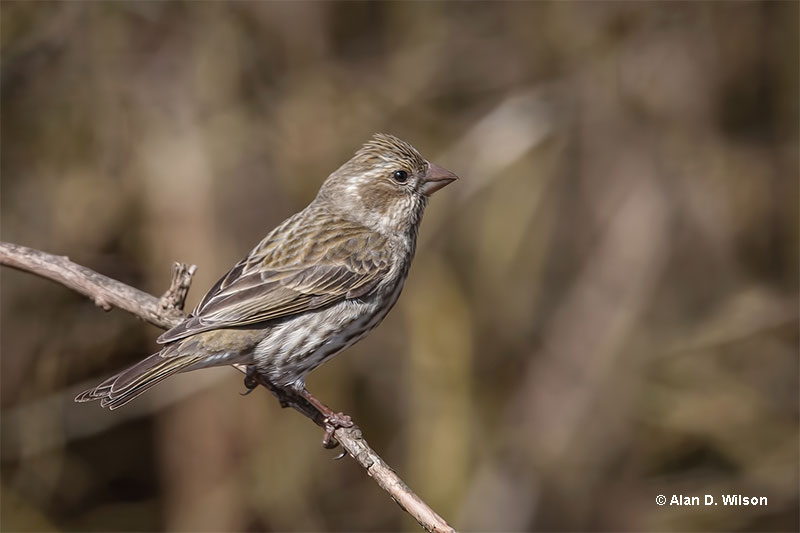
Female Purple Finch. © Alan D. Wilson
Juvenile
Juvenile Purple Finch looks like a female bird. The young will molt into adult plumage after their second year. Some immature males may show faint traces of red in their second year.
Vocalization
Purple Finch sings a warbling song, harmonious, sweet-sounding, and continuous. Sometimes, they’ll try to mimic other species’ repertoire. The songs often end in a descending trill.
The species also has specific calls – a musical “churlee,” a low “tek,” and a short “pit” in flight.
Range (and seasonal changes)
Purple Finch is found in most of North America, including parts of Mexico. It migrates seasonally across the continent or locally from higher to lower latitudes. However, exact migration patterns vary yearly, depending on food availability (mainly cone seed).
During the breeding season, the bird is found in southern parts of Canada, the northeastern United States, and in a few areas along the northwest.
After the nesting is over, the birds migrate to the eastern and southeastern parts of the US, as well as to the Pacific coast. If the cones are scarce, the Purple Finches will disperse more during the winter in search of food, frequently appearing even in urban areas.
The species is only rare in the Rocky Mountain region.
Habitat
This finch species is a forest bird that prefers to hang out in the canopies during the breeding season.
The types of forests they inhabit include humid and cool evergreen forests, mixed forests, wooded streambanks, etc.
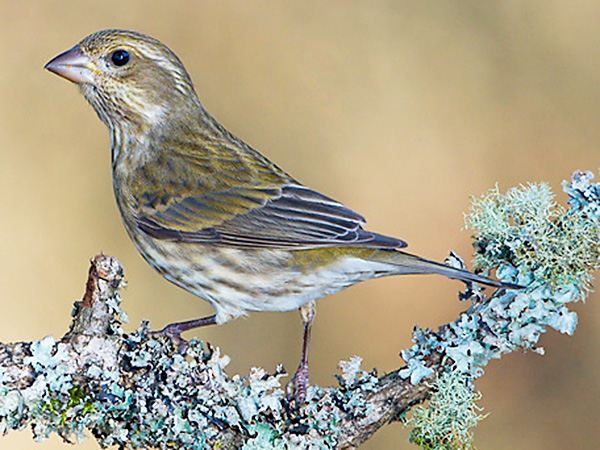
Female. Photograph © Glenn Bartley.
During the winter, Purple Finches are less picky about specific habitats and use forests, shrubland, hedgerows, fields with thick vegetation, and even backyards as overwintering habitats.
In the northern end of the range, this bird nests in coniferous trees, while in the southern end, it takes to deciduous species such as maple, oak, and wild cherry. More rarely, it will build nests in shrubs or sturdy vines.
Behavior
In the wintertime, Purple Ficnehs are social and gather in flocks in search of food. However, during the breeding season, they can get aggressive towards each other and competitor species. Both males and females defend their territories and nests.
An Agitated Purple Finch has a specific display to warn the competitor – it will lean towards them with a stretched-out neck, and the beak pointed at them. The next phase is standing upright and pointing and opening the beak at the rival, which can result in a pecking attack.
Sometimes, in any season, conflicts around food can arise. Interestingly, females are usually the winners of these duels.
Besides conflicts, Purple Finch males show their sweeter side during courtship.
Breeding and Nesting
The male has a detailed courtship ritual. He will hop around the female with fluffed feathers and drooping wings while singing softly. He may also hold an offer in his beak – a piece of nesting material such as a grass stem or a small twig.
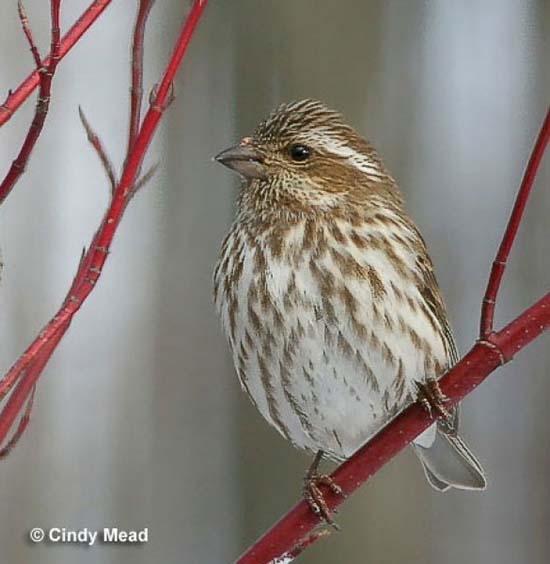
If the female seems approving, he will continue and vibrate his wings so intensely that he’ll lift himself up to a foot in the air.
If he proves himself right, mating transpires, and the female starts building the nest from twigs, roots, fine grass stems, and mammalian hair. She usually picks a far spot in the limb of a conifer tree, from 15 to 50 feet off the ground. The nest is also often cleverly built under an overhanging branch, providing additional shelter.
The female goes on to lay 3-6 pale bluish-green eggs with dark spots and markings. The incubation lasts for 12-13 days, and the chicks fledge in 13-16 days. There is usually one brood per year and possibly two in the Pacific region.
Diet
Purple Finch is omnivorous but primarily a seed eater. Its beak evolved for busting hard seeds of northern trees.
The main food items are conifer, elm, and maple seeds, although it will also enjoy others. During the winter, the bird will also go for the seeds of herbaceous plants such as ragweed, dandelions, thistle, and sunflower.
Additional food consists of young buds, nectar from the flower base, and various berries and fruits (honeysuckle, poison ivy and juniper berries, blackberries, cherries, etc.).
Animal protein is on the menu as well, so Purple Finch eats caterpillars, grasshoppers, aphids, and other arthropods. Insects are mostly eaten during the nesting season.
Conservation Status
It is estimated that there are 6.5 million breeding purple finches on the continent. The conservation concern is low.
However, the population is evidently decreasing. Between 1966 and 2019, it declined by about 32 percent – 0.73% per year. Still, due to the species’ extensive range, it doesn’t meet the criteria for being declared Vulnerable.
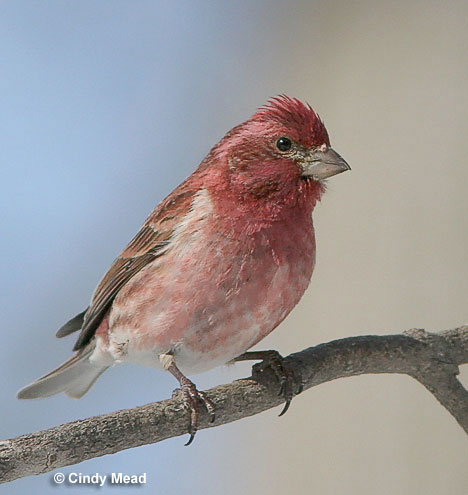
The factors contributing to the Purple Finch decline are habitat loss, climate change, cat predation, but also the success of a very close relative.
Originally found only in the west, the House Finch was spread into the east and is out-competing the Purple Finch. The House Finch is a more successful competitor in 95% of cases. The non-native Eurasian House Sparrow is also a rival species.
Fun Facts
- The species’ population is known to fluctuate, which seems to be partially cyclical. The fluctuations likely depend on the coniferous cone abundance and availability.
- Roger Tory Peterson, an American ornithologist, illustrator, and one of the inspirators of the environmental movement, famously described the Purple Finch as a “sparrow dipped in raspberry juice.”
- This finch was declared the state bird of New Hampshire in 1957.
Similar Species
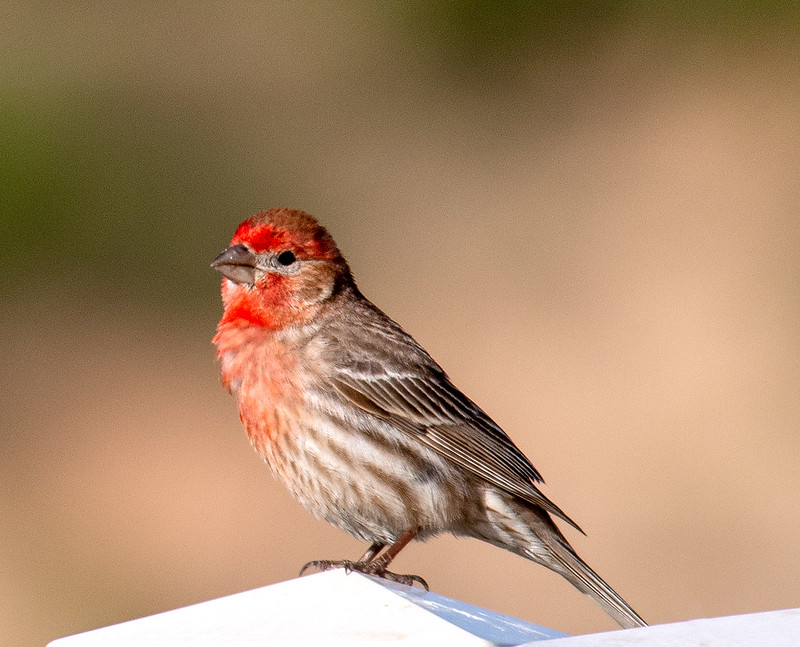
House Finch © John Hansen
Compared to Purple Finches, House Finches have darker bills and darker wings. They are a bit smaller than Purple Finches.
House Finches are common in most of the United States.
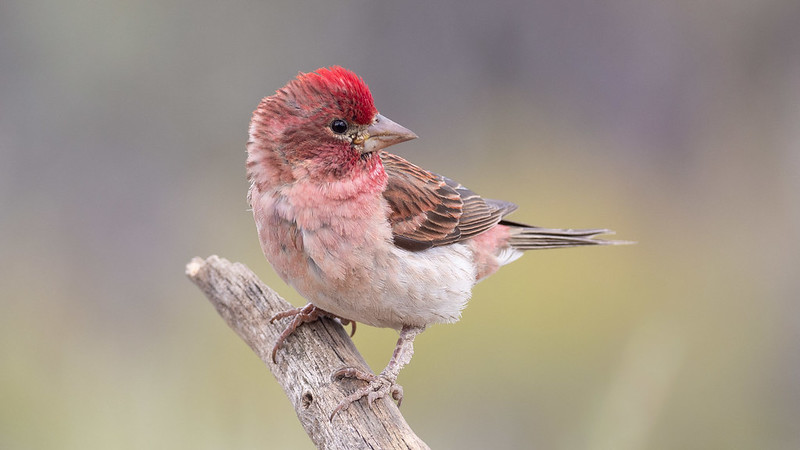
Cassin’s Finch. © David Renwald
Purple Finches and Cassin’s Finches look really similar. Identifying between the two can be tricky, but there are still a few ways to recognize them.
Cassin’s Finches have a darker red crown. Both birds have pink tones on their chests, but only Purple Finches have pink on their bellies.
Purple Finches are more common on the eastern side of the United States and on the West coast, while Cassin’s Finches are more common on the western side.
Both birds live in forests, but Cassin’s Finches can be seen looking for food on the ground.
Both are roughly the same size, but Purple Finches can be a bit smaller.
People Also Ask
How rare is a Purple Finch?
The bird is moderately common. It has a large range, but it is not observed regularly. It is a relatively rare visitor of birdfeeders, and due to the irregular migratory patterns, its potential arrival to a particular region is unpredictable. Still, you can try the Finch Forecast!
What is the difference between a Purple Finch and a House Finch?
These two species can be tricky to tell apart. The Purple Finch has a smoother and straighter profile with a head that is not as rounded as in the House Finch. Also, it has a heavier chest and looks like it’s sort of leaning forward. The beak of a Purple Finch is slightly more pointed. The tail is shorter in purple finches – the wing tips reach almost halfway down the tail, while in House Finches, it extends significantly beyond the wing tips. The tail feathers of Purple Finches are also more pointed.
Why is the Purple Finch important?
It plays an essential role in spreading some plant seeds, and keeping others in check, thereby helping control the spread of weeds and increasing plant diversity. Although it has been considered damaging to the orchards, the Purple Finch doesn’t consume so much fruit and flower buds to be truly harmful.
As a small bird, the Purple Finch is also an important part of the food web, being prey for many larger predators.
How long do Purple Finches live?
The oldest known Purple Finch caught in a North Carolina banding study in the 1970s was at least 12 years and 8 months old.

